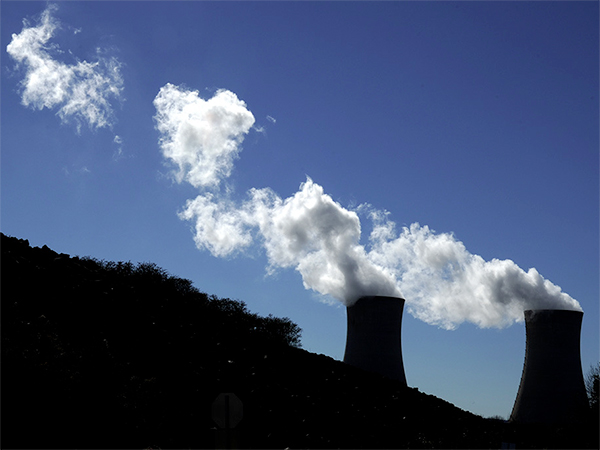After Fukushima, safety issues linger
Pa. has six reactors similar to those at Fukushima, and while regulators and reactor operators insist they are safe, a close scrutiny raises serious questions.
Clouds of condensed water vapor leave the cooling towers of the
Limerick nuclear power plant in Pottstown Monday, November 18, 2013.
CLEM MURRAY / Staff Photographer
Three years
ago this week, the world watched a nuclear accident unfold. Although
Fukushima Daiichi sits halfway around the globe, there are chilling
similarities between what happened in Japan and what could happen here.
Pennsylvania has six reactors that are of similar designs to those at Fukushima, two each at the Limerick, Susquehanna, and Peach Bottom nuclear plants. New Jersey has one each at the Hope Creek and Oyster Creek facilities. In addition to a shared technology, U.S. and Japanese regulatory systems have much in common.
But the most important thread that ties nuclear safety in this country with a nuclear disaster in Japan is a common mindset: that severe accidents are so unlikely they need not be rigorously considered in design, regulations, or emergency planning.
Even after the cascading crises at Fukushima stunned the world - and continue to grab headlines today - U.S. regulators and reactor operators insist that a similar event can't happen in this country. The existing nuclear safety net is adequate, they say.
But on close scrutiny those claims stretch credulity. Consider just
one component of that safety net, emergency planning at Peach Bottom,
south of Harrisburg.Pennsylvania has six reactors that are of similar designs to those at Fukushima, two each at the Limerick, Susquehanna, and Peach Bottom nuclear plants. New Jersey has one each at the Hope Creek and Oyster Creek facilities. In addition to a shared technology, U.S. and Japanese regulatory systems have much in common.
But the most important thread that ties nuclear safety in this country with a nuclear disaster in Japan is a common mindset: that severe accidents are so unlikely they need not be rigorously considered in design, regulations, or emergency planning.
Even after the cascading crises at Fukushima stunned the world - and continue to grab headlines today - U.S. regulators and reactor operators insist that a similar event can't happen in this country. The existing nuclear safety net is adequate, they say.
In the aftermath of Fukushima Daiichi, Peach Bottom's owner, Exelon Corp., which owns 17 reactors, submitted to the U.S. Nuclear Regulatory Commission its voluntary plan for responding to a severe accident, such as a flood or earthquake. Such events could destroy the reactors' electrical systems, making it impossible to cool the cores and spent reactor fuel, as happened at Fukushima.
At Fukushima Daiichi, all six reactors lost power, a situation called "station blackout." Despite the heroic efforts of workers, time ran out. Three meltdowns followed, along with hydrogen explosions and the release of massive amounts of radiation. It took nine days to restore full power.
Peach Bottom is adding portable generators to supply backup power in the event of such a crisis. But Exelon has proposed storing the equipment below flood level with the assumption that workers would have plenty of time to move the equipment and get it operating, an assumption consistent with nuclear-industry guidelines. Peach Bottom sits alongside the notoriously flood-prone Susquehanna and below a large dam. A dam breach or ice jam could create a destructive wall of water, akin to a tsunami.
Under Exelon's scenario, the disaster would leave electrical systems unscathed, the floodwaters or earthquake somehow miraculously sparing wiring that was not designed to withstand such events.
If that backup isn't enough, the utility is relying on additional emergency equipment - stored in Tennessee. Getting that equipment to the site in time to save the day after a disaster that disrupted transportation seems a rather high-stakes gamble. If by some chance the plant lost power during routine refueling, when the entire core is removed and placed in a spent fuel pool, there would be just eight hours before the pool began to boil dry and the fuel at risk of catching fire.
And what about evacuations in the event of a severe accident?
Central Pennsylvania is the only place in the United States that has actually experienced a nuclear evacuation - 35 years ago during the Three Mile Island accident. Then, the state recommended that pregnant women and children living within five miles of the plant leave. Instead, about 150,000 people took it upon themselves to flee, and the exodus was far from smooth.
During Fukushima, the NRC recommended that Americans living within 50 miles of the plant evacuate, a wise call based on a dangerous radiation plume that spread about 30 miles northwest of the reactors. Despite that experience, the NRC today remains steadfast in its belief that the existing 10-mile emergency evacuation zone around U.S. nuclear plants is adequate and that there would be plenty of time to expand that zone if conditions warranted. (In the case of the Limerick reactor, a 50-mile zone would include much of metropolitan Philadelphia.)
More than 10 million Pennsylvanians (80 percent of the state) live within 50 miles of a nuclear plant. That statistic prompted Sen. Robert Casey (D., Pa.) in 2012 to ask the NRC to reevaluate the adequacy of the 10-mile evacuation zone. The 10-mile zone remains in effect.
Three years after Fukushima Daiichi, the NRC and the nuclear industry continue to repeat a familiar mantra: The likelihood of a severe accident is so low there is no need to plan for it. That was what the Japanese said, too.
Susan Q. Stranahan is co-author of the new book "Fukushima: The Story of a Nuclear Accident," written with David Lochbaum and Edwin Lyman of the Union of Concerned Scientists. She was a member of the Inquirer team awarded a Pulitzer Prize for its coverage of the Three Mile Island accident susan.stranahan@gmail.com





No comments:
Post a Comment